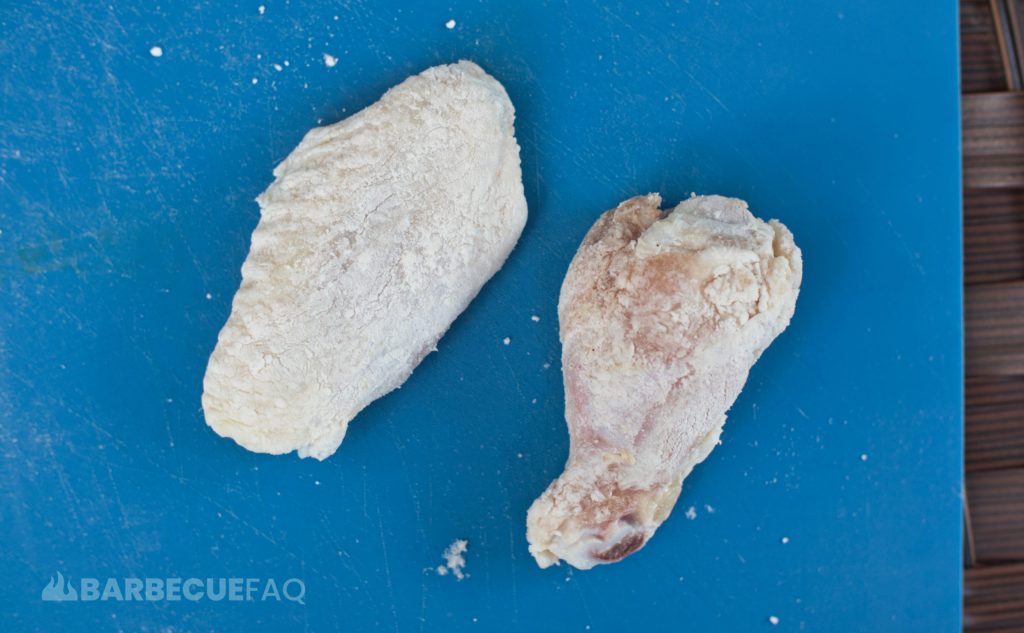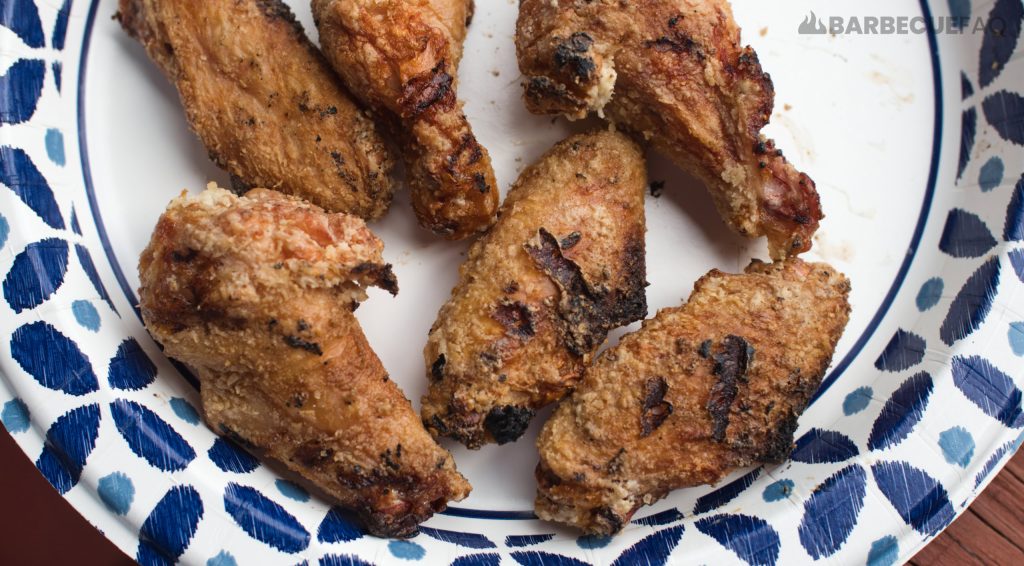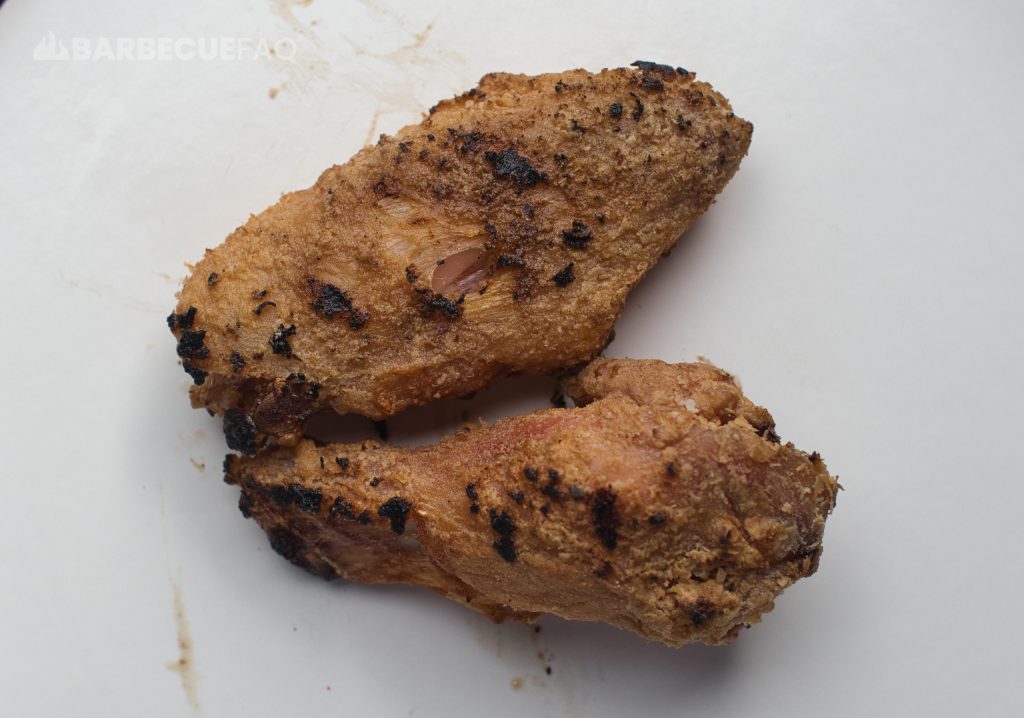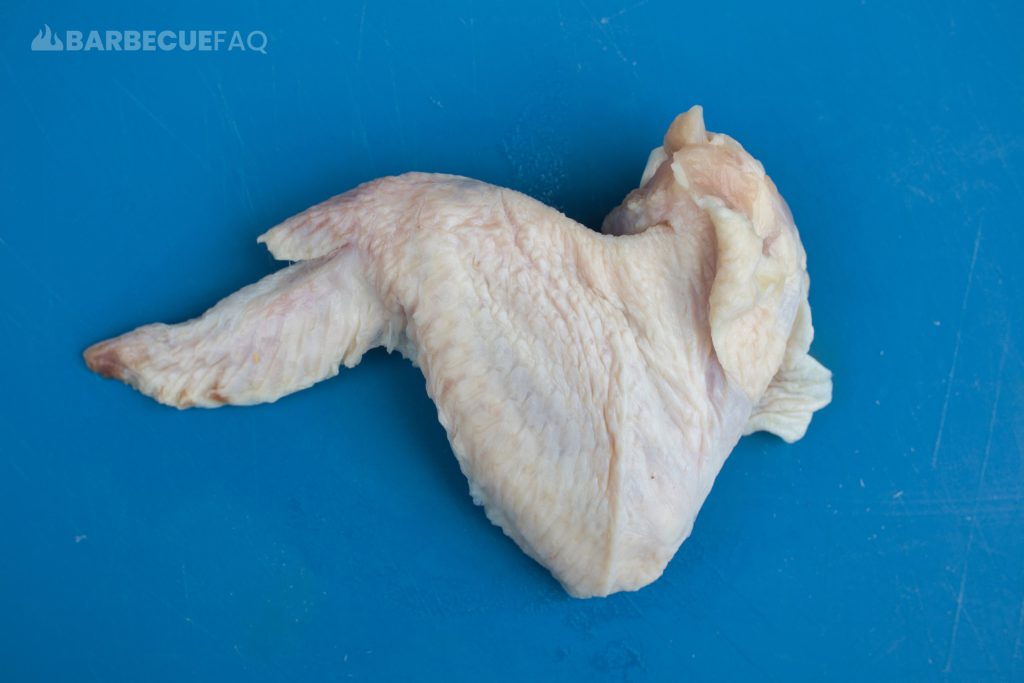In my opinion, cornstarch works best for chicken wings – especially when making them on a grill or baking in the oven.
Baking powder almost has a gritty taste that’s off-putting and lacks the “crunch” that most Readers are likely chasing.
Testing Cornstarch vs Baking Powder for Chicken Wings
While I’ve already tested this concept before and I know the end result, I wanted to re-test this for the sake of the article.
Here’s a picture of the cornstarch wings before grilling:

Here’s a picture of the baking powder wings before grilling:

Here’s a picture of the cornstarch wings after grilling:

Here’s a picture of the baking powder wings after grilling:

Something that’s worth noting is that during the grilling process, the baking powder wing “set up” faster.
This could be simply due to the fact that there was less baking powder on the wing itself or it could be the inherent properties of baking powder in comparison to the cornstarch.
Here’s a picture about half way through grilling the wings:

Which is Best?
Visually, there isn’t a ton of difference in the end product.
However, taste-wise there is a huge difference.
I had my parents test the baking powder wings first – I also took a bite myself.
The surface of the wing almost feel “sandy” in the mouth; You can tell it wants to be crispy but it’s just super lacking.
To quote my Mom: “These don’t hold a torch to your wings.”
I then offered them my regular cornstarch wings with and without sauce and both of them remarked that they were way better.
Help! I Used Cornstarch and They Still Don’t Have Crispy Skin
In almost every case it’s because you didn’t go to a high enough internal temperature.
Wings are similar to dark meat – meaning you can push the internal temperature up to 200F – and the wings will remain moist/tender inside.
By cooking longer you’ll render more skin fat and the meat will cleanly and easily pull off the bone.

Why Cornstarch Works Best for Wings
Cornstarch is almost entirely starch – where-as flour contains gluten.
The more starch something has the greater the water absorption. This leads to the enhanced gelatinization of starches.

This same thing happens when starch is applied to a wet surface – like a wing.
The starch granules swell and absorb water – as the wing is heated it pushes out moisture. The subsequent heating causes the granule size to increase until they can no longer absorb water and they burst.
The result is a super crunchy, moist wing.

Why Baking Powder can Work for Wings
Most home baking powders are “double-acting.”
Meaning, there are two reactions – first when the baking powder comes into contact with a liquid and second when it’s heated.

These are good qualities to have in our scenario. The baking powder will dry out the surface of the skin and then activate when it’s heated.
Note: If you opt to use baking powder, ensure it’s aluminum-free.
To me though, the sandy/gritty taste is gross.
Cornstarch is Cheaper than Baking Powder
Something that’s worth noting is that corn starch is a bit cheaper than baking powder – almost half the cost.
I typically buy corn starch from Walmart and use their Great Value brand:
- Corn starch: $1.54 for 16 oz.
- Baking powder: $1.48 for 8 oz.
So you can get double the amount of corn starch for roughly the same price as baking powder.





14 comments
Edward
At what high temperature and time in the oven?
Dylan Clay
Hi Edward!
So I use my pellet grill for wings which is basically just an outdoor oven – as it’s just convection heat.
But ~425F is usually around what I use.
On my grill these take ~45 minutes to reach 200F internal, but it might take longer in the oven. See my notes in this article as to why 200F is preferred for this wing type.
Ensure your oven is accurate too – often they’re off by as much as 20F.
Hope that helps!
-Dylan
Susie Handy-Rountree
Thank you for this very useful information. I did the test also, and you are correct. Corn starch way better. Question abt beef jerky….
Would you or have you ever used corn starch to assist in the drying process. I hang my beef jerky in the oven on the racks
Thank you again.
Dylan Clay
Hi Susie! Happy to help.
So I’ve been making beef jerky for over 17 years and I’ve never used corn starch in my marinade to aid in dehydration. The convective heat in your oven is what dries out the jerky, not the marinade ingredients.
If you used corn starch, what you’d essentially be doing is called “velveting” the meat – which is common for Chinese takeaway for things like beef stir fry.
But the kicker is you’re cooking the beef at high heat – the opposite of dehydration.
The corn starch coating on the exterior of this meat is a layer of now hydrated starch which lubricates the surface, giving the impression of “moist” meat when the interior might be dry.
What you’d be better off doing (especially if you’re after soft jerky) is using a humectant in your marinade – I’ve written about this texture at length in this article.
Hope that helps!
Rob
Do you oil wings before dredging them in cornstarch and what spices do you use
Dylan Clay
Hey Rob!
So no oil what-so-ever – A binder isn’t necessary here as the wings are wet out of the packaging, meaning the cornstarch sticks without an issue. Whenever I make wings I quite literally will take a cheap plastic trash bag, put all my wings in the bag (usually it’s like 60+), then add about half a bottle of the cornstarch, then shake the bag; Then onto my pellet grill they go.
Also with regards to the spices, I’ve tested this many times and you won’t taste any spices that get added, at all. I made wings about 2 weeks ago and re-tested this with a wing rub my brother-in-law bought me and you still can’t taste the spice. Granted, I sauce my wings so that’s likely why. If you intend to sauce your wings I’d suggest just using cornstarch.
Jay Seigfreid
I have exclusively been doing baking powder wings in the air fryer and my opinion is the same as yours. Will try the corn starch wings tonight.
Dylan Clay
Let me know what you think Jay – I’ve actually yet to make wings in my Air Fryer, but I’d assume my opinion wouldn’t change much.
-Dylan
Laura
Your article was very helpful. Making wings to take to a party and decided to try a different recipe. Hadn’t heard of using cornstarch before. Going to give it a try!
Dylan Clay
Happy to help Laura! Hopefully they’re family/friend approved.
Roberta M Westbrooks
We are having wings for the super bowl.
I will definitely try the corn starch, my hubby has a air fryer, his favorite kitchen appliance:)
Thanks, enjoy the super bowl 🏈 🥣 😉
Dylan Clay
Let me know how it goes Roberta! Hopefully it’s “hubby” approved.
Anita
I don’t grill. I’m using my oven. Is it still better to use corn starch? Thx Anita
Dylan Clay
Hey Anita!
So at the end of the day, heat is heat and BTU is BTU. Both the grill and the oven create a convection of heat and your wings don’t know if the grill is cooking them or if an oven is. Even if you’re using an oven, I’d still rather use Corn Starch.